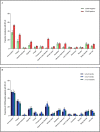Post‑COVID‑19 Syndrome in Outpatients: a Cohort Study
- PMID: 35319081
- PMCID: PMC8939498
- DOI: 10.1007/s11606-021-07242-1
Post‑COVID‑19 Syndrome in Outpatients: a Cohort Study
Abstract
Background: After mild COVID-19, some outpatients experience persistent symptoms. However, data are scarce and prospective studies are urgently needed.
Objectives: To characterize the post-COVID-19 syndrome after mild COVID-19 and identify predictors.
Participants: Outpatients with symptoms suggestive of COVID-19 with (1) PCR-confirmed COVID-19 (COVID-positive) or (2) SARS-CoV-2 negative PCR (COVID-negative).
Design: Monocentric cohort study with prospective phone interview between more than 3 months to 10 months after initial visit to the emergency department and outpatient clinics.
Main measures: Data of the initial visits were extracted from the electronic medical file. Predefined persistent symptoms were assessed through a structured phone interview. Associations between long-term symptoms and PCR results, as well as predictors of persistent symptoms among COVID-positive, were evaluated by multivariate logistic regression adjusted for age, gender, smoking, comorbidities, and timing of the survey.
Key results: The study population consisted of 418 COVID-positive and 89 COVID-negative patients, mostly young adults (median age of 41 versus 36 years in COVID-positive and COVID-negative, respectively; p = 0.020) and healthcare workers (67% versus 82%; p = 0.006). Median time between the initial visit and the phone survey was 150 days in COVID-positive and 242 days in COVID-negative patients. Persistent symptoms were reported by 223 (53%) COVID-positive and 33 (37%) COVID-negative patients (p = 0.006) and proportions were stable among the periods of the phone interviews. Overall, 21% COVID-positive and 15% COVID-negative patients (p = 0.182) attended care for this purpose. Four surveyed symptoms were independently associated with COVID-19: fatigue (adjusted odds ratio 2.14, 95% CI 1.04-4.41), smell/taste disorder (26.5, 3.46-202), dyspnea (2.81, 1.10-7.16), and memory impairment (5.71, 1.53-21.3). Among COVID-positive, female gender (1.67, 1.09-2.56) and overweight/obesity (1.67, 1.10-2.56) were predictors of persistent symptoms.
Conclusions: More than half of COVID-positive outpatients report persistent symptoms up to 10 months after a mild disease. Only 4 of 14 symptoms were associated with COVID-19 status. The symptoms and predictors of the post-COVID-19 syndrome need further characterization as this condition places a significant burden on society.
Keywords: Post-COVID-19 syndrome; Post-acute COVID-19 syndrome; obesity.
© 2022. The Author(s) under exclusive licence to Society of General Internal Medicine.
Conflict of interest statement
The authors declare that they do not have a conflict of interest.
Figures



Similar articles
-
Virtualized clinical studies to assess the natural history and impact of gut microbiome modulation in non-hospitalized patients with mild to moderate COVID-19 a randomized, open-label, prospective study with a parallel group study evaluating the physiologic effects of KB109 on gut microbiota structure and function: a structured summary of a study protocol for a randomized controlled study.Trials. 2021 Apr 2;22(1):245. doi: 10.1186/s13063-021-05157-0. Trials. 2021. PMID: 33810796 Free PMC article.
-
Prevalence and predictors of Post-Acute COVID-19 Syndrome (PACS) after hospital discharge: A cohort study with 4 months median follow-up.PLoS One. 2021 Dec 7;16(12):e0260568. doi: 10.1371/journal.pone.0260568. eCollection 2021. PLoS One. 2021. PMID: 34874962 Free PMC article.
-
Female gender is associated with long COVID syndrome: a prospective cohort study.Clin Microbiol Infect. 2022 Apr;28(4):611.e9-611.e16. doi: 10.1016/j.cmi.2021.11.002. Epub 2021 Nov 9. Clin Microbiol Infect. 2022. PMID: 34763058 Free PMC article.
-
Signs and symptoms to determine if a patient presenting in primary care or hospital outpatient settings has COVID-19.Cochrane Database Syst Rev. 2021 Feb 23;2(2):CD013665. doi: 10.1002/14651858.CD013665.pub2. Cochrane Database Syst Rev. 2021. Update in: Cochrane Database Syst Rev. 2022 May 20;5:CD013665. doi: 10.1002/14651858.CD013665.pub3. PMID: 33620086 Free PMC article. Updated.
-
Long COVID prevalence and physiology-centered risks: population-based study in Ukraine.Inflammopharmacology. 2023 Apr;31(2):597-602. doi: 10.1007/s10787-023-01177-1. Epub 2023 Mar 22. Inflammopharmacology. 2023. PMID: 36947300 Free PMC article. Review.
Cited by
-
Age, Sex and Previous Comorbidities as Risk Factors Not Associated with SARS-CoV-2 Infection for Long COVID-19: A Systematic Review and Meta-Analysis.J Clin Med. 2022 Dec 9;11(24):7314. doi: 10.3390/jcm11247314. J Clin Med. 2022. PMID: 36555931 Free PMC article. Review.
-
Quality of Life and Persistence of Symptoms in Outpatients after Recovery from COVID-19.Medicina (Kaunas). 2022 Dec 6;58(12):1795. doi: 10.3390/medicina58121795. Medicina (Kaunas). 2022. PMID: 36556998 Free PMC article.
-
Does sex modify the effect of pre-pandemic body mass index on the risk of Long COVID? Evidence from the longitudinal analysis of the Survey of Health, Ageing and Retirement in Europe.Int J Obes (Lond). 2024 Jun;48(6):821-829. doi: 10.1038/s41366-024-01477-8. Epub 2024 Jan 29. Int J Obes (Lond). 2024. PMID: 38287094
-
A systematic analysis of neurologic manifestations of Long COVID in Nigeria.J Neurovirol. 2024 Dec;30(5-6):524-533. doi: 10.1007/s13365-024-01232-9. Epub 2024 Oct 24. J Neurovirol. 2024. PMID: 39446250
-
Life stressors significantly impact long-term outcomes and post-acute symptoms 12-months after COVID-19 hospitalization.J Neurol Sci. 2022 Dec 15;443:120487. doi: 10.1016/j.jns.2022.120487. Epub 2022 Nov 5. J Neurol Sci. 2022. PMID: 36379135 Free PMC article.
References
-
- Wu Z, McGoogan JM. Characteristics of and Important Lessons From the Coronavirus Disease 2019 (COVID-19) Outbreak in China: Summary of a Report of 72 314 Cases From the Chinese Center for Disease Control and Prevention. JAMA. 2020 Apr 7;323(13):1239–42. - PubMed
-
- Tenforde MW, Kim SS, Lindsell CJ, Billig Rose E, Shapiro NI, Files DC, et al. Symptom Duration and Risk Factors for Delayed Return to Usual Health Among Outpatients with COVID-19 in a Multistate Health Care Systems Network — United States, March–June 2020. MMWR Morb Mortal Wkly Rep. 2020 Jul 31;69(30):993–8. - PMC - PubMed
Publication types
MeSH terms
LinkOut - more resources
Full Text Sources
Medical
Miscellaneous

